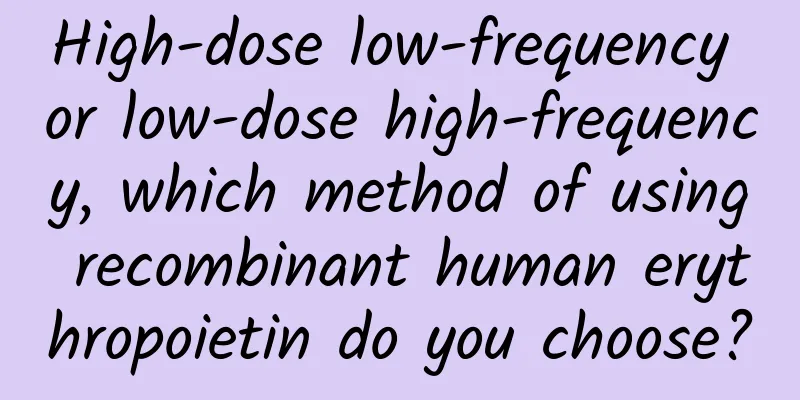High-dose low-frequency or low-dose high-frequency, which method of using recombinant human erythropoietin do you choose?

|
Erythropoietin is an active glycoprotein secreted by the kidneys. It acts on erythroid hematopoietic progenitor cells in the bone marrow, promoting their proliferation and differentiation to form red blood cells. Chronic kidney disease patients cannot secrete enough erythropoietin due to kidney failure, resulting in renal anemia. Therefore, sufficient erythropoietin needs to be supplemented artificially to correct renal anemia. Erythropoiesis-stimulating agents (ESAs), represented by recombinant human erythropoietin (rHEPO), have been successfully used to treat renal anemia for more than 30 years and are still the main drugs for the treatment of renal anemia. There are two common rHEPO dosage forms and usages in clinical practice: subcutaneous injection of 3000 U/time, 2-3 times/week; subcutaneous injection of 10,000 U/time, once/week [1]. The comparison of the efficacy and safety of the two usages of this drug has always been a research hotspot. In fact, domestic and foreign studies have long confirmed that the use of high-dose rHEPO once a week is a safe and effective treatment method. High-dose rHEPO can stably increase hemoglobin (Hb) levels, and there is no significant difference in adverse reactions compared with low-dose, high-frequency use of rHEPO [2-7]. This article briefly introduces the relevant domestic research. Observation on the efficacy of high-dose erythropoietin in the treatment of renal anemia [5] Research methods: Patients with renal anemia due to chronic renal insufficiency were selected. The observation group received a high-dose erythropoietin injection of 10,000 U subcutaneously once a week. The control group received a subcutaneous injection of 3,000 U erythropoietin 2 to 3 times a week. The Hb, hematocrit, red blood cell level and adverse reactions during the treatment were observed. Research results: There was no statistically significant difference between the two groups, and there was no significant change in electrolytes and liver function before and after treatment. Research conclusion: There is no statistically significant difference in the efficacy and adverse reactions between high-dose erythropoietin (1 time/week) and conventional dose erythropoietin (2-3 times/week) in the treatment of renal anemia, but reducing the number of injections can improve patients' treatment compliance. Observation on the efficacy of high-dose rHEPO in the treatment of uremic anemia[6] Research methods: 20 hemodialysis patients with uremia and renal anemia were randomly divided into two groups. The experimental group (10 cases) was treated with subcutaneous injection of domestic rHEPO 10 000 U once a week; the control group (10 cases) was treated with subcutaneous injection of imported rHEPO 3000 U 2-3 times a week. During the treatment, blood routine, blood lipids, liver and kidney function, electrolytes, blood pressure and other indicators and various adverse reactions of the patients were monitored. Research results: In the experimental group, 5 cases were markedly effective, 4 cases were effective, and 1 case was ineffective; in the control group, 6 cases were markedly effective, 3 cases were effective, and 1 case was ineffective. There were no significant changes in white blood cells, platelets, blood lipids, liver and kidney functions, and electrolytes before and after treatment. Conclusion: High-dose rHEPO once a week is safe and reliable for the treatment of renal anemia, with definite efficacy and the incidence of adverse reactions is similar to that of the control group. There are also relevant studies in China on the efficacy and safety of high-dose rHEPO. Efficacy and safety of high-dose rHEPO in the treatment of renal anemia in hemodialysis patients[7] Methods: A total of 203 hemodialysis patients with renal anemia in 24 hemodialysis centers in Shanghai were selected and given rHEPO 10 000 U/week from February to August 2002. When Hb rose rapidly to 100 g/L, the dosage could be reduced to once every 2 weeks or even less, and the patients were observed for 20-24 weeks. A total of 185 cases completed the validation. According to the initial Hb (Hb0), the patients were divided into group A (50 g/L≤Hb0<70 g/L), group B (70 g/L≤Hb0<90 g/L) and group C (Hb0≥90 g/L); according to the dialysis age, the patients were divided into group a (dialysis age<3 months), group b (3 months≤dialysis age<60 months) and group c (≥60 months). Results: After treatment, Hb in groups A, B, and C increased, with effective rates of 67.5%, 85.7%, and 89.8%, respectively, and an average effective rate of 81.6%. Hb in each dialysis age group also tended to increase. In 16 patients, rHEPO was reduced to once every 2 weeks from 4 to 12 weeks, and Hb did not decrease significantly. During the verification process, 16 patients experienced 22 adverse drug events, mainly hypertension, headache, etc., but the correlation with rHEPO was low. Conclusion: High-dose rHEPO can effectively correct renal anemia in hemodialysis patients and has high safety. Although most studies believe that high-dose, low-frequency use of rHEPO is better than low-dose, high-frequency use, some studies hold opposing views. A 2020 study concluded that high-dose single and low-dose multiple use of rHEPO are equally effective in the treatment of renal anemia in maintenance hemodialysis, but low-dose multiple use is safer [8]. summary In fact, both the high-frequency use of small doses and the low-frequency use of large doses of rHEPO have their own advantages and disadvantages. Multiple uses of small doses can reduce Hb fluctuations, but it increases the workload of medical staff and increases the adverse experience of patients during injections, which will lead to poor treatment compliance of patients. Reducing the frequency of rhEPO administration and extending the interval between medications can reduce the number of injections and the number of times patients experience pain, thereby improving patients' treatment compliance and quality of life and reducing the workload of medical staff. At the same time, it also reduces the number of patient visits and medical expenses. Regarding the selection of rhEPO usage and dosage, it is recommended to make individualized choices based on the patient's specific situation during clinical treatment to bring greater benefits to patients. It should be noted that for patients with low response to ESAs, it is necessary to find the cause of low response to ESAs, rather than simply increasing the dose of rHEPO. During the treatment with ESAs, regular monitoring of the patient's Hb level and individualized adjustments based on the patient's specific situation can ensure the effectiveness and safety of the treatment and bring greater benefits to patients. References: [1] Zeng Qiao, Li Qi, Zhong Qingrong, et al. Observation on the efficacy of iron sucrose combined with erythropoietin in the treatment of renal anemia in patients undergoing maintenance hemodialysis [J]. Hainan Medical Journal, 2013, 24(23): 3457-3459. [2]Efficiency of Once-Weekly Subcutaneous Administration of Recombinant Human Erythropoietin versus Three Times a Week Administration in Hemodialysis .Patients Letter to the Editor; Nephron 1996;72:723-724 [3]The Management of anemia in pediatric peritoneal Dialysis patients.GUIDELINES BY AN AD HOC EUROPEAN COMMITTEE.January 4, 2003 [4] Pablo E. Pergola, Gary Gartenberg, MinFu, et al. A Randomized Controlled Study of Weekly and Biweekly Dosing of Epoetin Alfain CKD Patients With Anemia. ClinJAmSocNephrol4: 1731–1740, 2009. [5] Huang Zanwei, Feng Xiaolan. Observation on the efficacy of high-dose erythropoietin in the treatment of renal anemia [J]. Modern Medicine and Health, 2007, 23 (16): 2. [6] Wu Jun, Yuan Zhizhong, Ye Chaoyang, et al. Observation on the therapeutic effect of high-dose recombinant human erythropoietin in the treatment of uremic anemia [J]. Journal of Second Military Medical University, 2002, 23(11): 3. [7] Gu Yong, Shi Xuefeng. Efficacy and safety of high-dose recombinant human erythropoietin in the treatment of renal anemia in hemodialysis patients[J]. Chinese Journal of Clinical Pharmacy, 2004, 13(2): 4. [8] Ge Zhenhua. Comparative study on the effects of different doses of recombinant human erythropoietin in the treatment of renal anemia in maintenance hemodialysis[J]. Journal of Clinical Rational Drug Use, 2020, 13(12): 69-70. |
<<: Understand in one article | How to measure glomerular filtration rate?
Recommend
People with alkaline constitution are more likely to give birth to sons
In life, many people believe in some ancient folk...
Colposcopic biopsy
Colposcopic biopsy is a gynecological endoscope. ...
eMarketer: WeChat is unlikely to become a marketing tool for international companies in China
199IT original compilation Last week, a group of ...
How do women regulate menopause?
Every woman will enter menopause. Some women have...
Why are women more prone to urinary tract infections?
In life, women are more likely to suffer from uri...
My period is here
When your period comes, it is mainly the shedding...
The new coronavirus JN.1 variant is coming? This little thing must be done well
Recently, a wave of new coronavirus infections ha...
Bleeding after abortion
With the development of modern medical technology...
One month into pregnancy, should I choose medical abortion or surgical abortion?
Some women will choose to have an abortion when t...
What are the uses of gynecological Chinese medicine wash?
Many female friends are afraid that they will suf...
Can I take medicine for a cold during the confinement period?
You cannot take cold medicine during the confinem...
Be careful when large pieces of teeth fall out! Why is it not as simple as dental implants?
July 23 is World Dry Day. Sjögren's syndrome ...
How to exercise for pelvic inflammatory disease
As time goes by and we age, our bodies will becom...
How to treat vulvar atrophic lichen
For friends suffering from vulvar atrophic lichen...
What to do if there is a bad smell during pregnancy
Women can be said to be very happy during pregnan...









